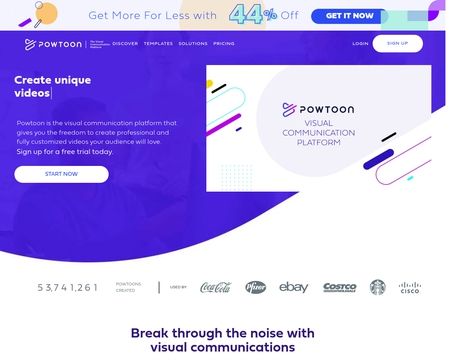Powtoon is an online platform for creating short video presentations. Powtoon gives anyone the ability to create professional videos and presentations. You can select from royalty-free libraries of animation, live-action video, images, designed backgrounds, soundtracks, and moving graphics, or you can use your own visual content and voiceover.
Powtoon's Founder and CEO, Ilya Spitalnik said, 'I'm excited to see how Powtoon makes it easier for Microsoft Teams users to deliver information through video, and more importantly, to collaborate, comment, and receive instant feedback on videos they're working on.' By integrating into the Teams environment, users can now. We offer highest quality Powtoon videos at VERY cheap prices. We charge only $185 for animated videos that are around 30 seconds in length. Yep, you read that right, just $185/30sec and it includes all from script writing, design, animation, voiceover, music, sound effects and an HD video. While animation companies charge between $2,000.

Students can create quality animated video presentations to showcase their understanding of a specific topic. Teachers can also create their own Powtoons as an alternative approach to teaching topics.
Tool Snapshot

| Price | Student, Teacher, and Classroom Plans |
| Learning | Constructionism |
| Ease of Use | ★★✩✩✩ |
| Privacy | ★★★✩✩ |
| Accessibility | ★✩✩✩✩ |
| Class Size | One user per account |
| Login | Yes |
| ISTE*S | Creative Communicator, Global Collaborator |
| COPPA/ FERPA | Yes |
Powtoon Overview Video


Powtoon & the SAMR Model
Dr. Ruben Puentedura’s SAMR model offers a lens for examining how technology is adopted in a classroom. As you strive to incorporate online tools into your classroom, we encourage you to use this model as an analytic tool.
Here is an example of how Powtoon might fit the SAMR model:
- Substitution: Students use Powtoon to create a short, digital presentation (instead of giving an in-person presentation).
- Augmentation: Students create a multimodal video that presents their understanding and knowledge of a topic.
- Modification: Students can create professional quality whiteboard animation video without any prior graphic design/animation knowledge or skills.
- Redefinition: Students can collaborate with peers and professionals located around the world on a Powtoon.
Here is an example of what you can get your Powtoon to look like! Here we have a Powtoon character in a classroom setting discussing climate change.
Learning Activities
Science: Students can create a Powtoon that takes you on a tour of a cell or walks youthrough the step-by-step process of a lab experiment.
English/Language Arts: Students can create a Powtoon as a book report.

Arts: Students can describe significant historical painters or musicians in their Powtoon.
Other: Students can introduce themselves to a new class by creating a Powtoon about them.
Resources
How to Use Powtoon
Animaker
- Step 1: Script: Create a script that describes what will happen in every “scene”.
- Step 2: Voice-Over Guide / Background Music: Choose a background track for your music or record a voice-over guide. This means that you need an mp3 file of the TEXT PARTS of the script read out as they will appear in the Powtoon.
- Step 3: Dividing the Slides: Start creating slides according to the script. Each slide represents a scene and an idea as outlined in the script. Try to keep your slides short, this way you can put a lot of interesting visuals in your Powtoon.
- Step 4: Populate the Slides: Now it’s time to add graphics, background, props, images and characters to your slides.
- Step 5: Timing: Now you have to time it all. This is the last step and is actually one that can have a significant effect on the “professional” look and feel of your final result. The PowToon timeline is designed to allow you to easily adjust the appearance and timing of all the elements on the screen.
Research
Powtoon Free Download
Rioseco Pais, M. H., Nogués, F. P., & Muñoz, B. R. (2017). Incorporating powtoon as a learning activity into a course on technological innovations as didactic resources for pedagogy programs. International Journal of Emerging Technologies in Learning, 12(6), 120.